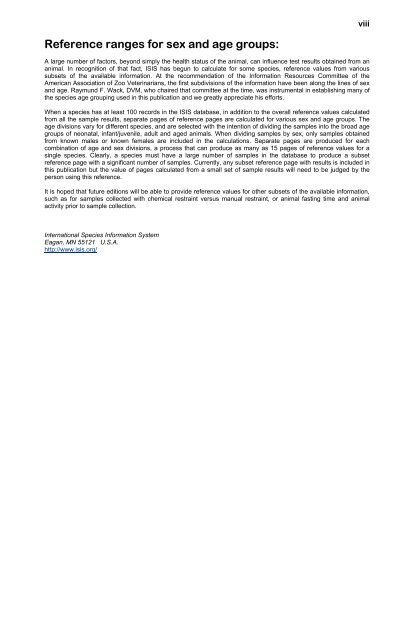Physiological Data Reference Values for Tapir Species
Physiological Data Reference Values for Tapir Species
Physiological Data Reference Values for Tapir Species
You also want an ePaper? Increase the reach of your titles
YUMPU automatically turns print PDFs into web optimized ePapers that Google loves.
<strong>Reference</strong> ranges <strong>for</strong> sex and age groups:<br />
A large number of factors, beyond simply the health status of the animal, can influence test results obtained from an<br />
animal. In recognition of that fact, ISIS has begun to calculate <strong>for</strong> some species, reference values from various<br />
subsets of the available in<strong>for</strong>mation. At the recommendation of the In<strong>for</strong>mation Resources Committee of the<br />
American Association of Zoo Veterinarians, the first subdivisions of the in<strong>for</strong>mation have been along the lines of sex<br />
and age. Raymund F. Wack, DVM, who chaired that committee at the time, was instrumental in establishing many of<br />
the species age grouping used in this publication and we greatly appreciate his ef<strong>for</strong>ts.<br />
When a species has at least 100 records in the ISIS database, in addition to the overall reference values calculated<br />
from all the sample results, separate pages of reference pages are calculated <strong>for</strong> various sex and age groups. The<br />
age divisions vary <strong>for</strong> different species, and are selected with the intention of dividing the samples into the broad age<br />
groups of neonatal, infant/juvenile, adult and aged animals. When dividing samples by sex, only samples obtained<br />
from known males or known females are included in the calculations. Separate pages are produced <strong>for</strong> each<br />
combination of age and sex divisions, a process that can produce as many as 15 pages of reference values <strong>for</strong> a<br />
single species. Clearly, a species must have a large number of samples in the database to produce a subset<br />
reference page with a significant number of samples. Currently, any subset reference page with results is included in<br />
this publication but the value of pages calculated from a small set of sample results will need to be judged by the<br />
person using this reference.<br />
It is hoped that future editions will be able to provide reference values <strong>for</strong> other subsets of the available in<strong>for</strong>mation,<br />
such as <strong>for</strong> samples collected with chemical restraint versus manual restraint, or animal fasting time and animal<br />
activity prior to sample collection.<br />
International <strong>Species</strong> In<strong>for</strong>mation System<br />
Eagan, MN 55121 U.S.A.<br />
http://www.isis.org/<br />
viii










